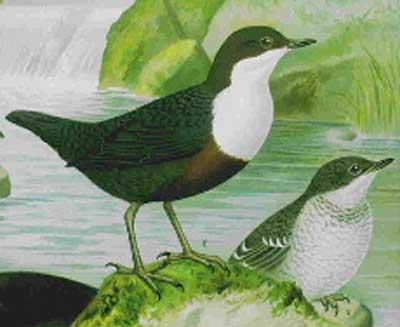Cinclus cinclus (*) Cladus: Eukaryota Name Cinclus cinclus (Linnaeus, 1758) Vernacular names The White-throated Dipper (Cinclus cinclus), also known as the European Dipper or just Dipper is an aquatic passerine bird found in Europe and the Middle East. The species is divided into several subspecies, based primarily on colour differences, particularly of the pectoral band. The White-throated Dipper is Norway's national bird.[3] Description The White-throated Dipper is about 18 centimetres (7.1 in) long, rotund and short tailed. The head of the adult (gularis and aquaticus) is brown, the back slate-grey mottled with black, looking black from a distance, and the wings and tail are brown. The throat and upper breast are white, followed by a band of warm chestnut which merges into black on the belly and flanks. The bill is almost black, the legs and irides brown. C. c. cinclus has a black belly band. The young are greyish brown and have no chestnut band. Voice The male has a sweet Wren-like song. During courtship the male sings whilst he runs and postures, exhibiting his snowy breast, and when displaying he will take long and high flights, like those of the Common Kingfisher, accompanied by sharp metallic calls clink, clink, different from the normal zil. Taxonomy The nominate Black-bellied Dipper, C. c. cinclus, has no chestnut on the lower breast. It breeds in northern Europe and wanders to milder regions in winter. It has been recorded from the United Kingdom on many occasions. The Dipper of Great Britain and Ireland, C. c. gularis and the central European race C. c. aquaticus are mainly resident. The Cyprus population became extinct in the early 1950s. It has been described as a distinct subspecies, the Cyprus Dipper (C. c. olympicus), but its validity is doubtful. Behaviour The White-throated Dipper is closely associated with swiftly running rivers and streams or the lakes into which these fall. It often perches bobbing spasmodically with its short tail uplifted on the rocks round which the water swirls and tumbles. It acquired its name from these sudden dips, not from its diving habit, though it dives as well as walks into the water. It flies rapidly and straight, its short wings whirring swiftly and without pauses or glides, calling a shrill zil, zil, zil. It will then either drop on the water and dive or plunge in with a small splash. From a perch it will walk into the water and deliberately submerge, but there is no truth in the assertion that it can defy the laws of specific gravity and walk along the bottom . Undoubtedly when entering the water it grips with its strong feet, but the method of progression beneath the surface is by swimming, using the wings effectively for flying under water. It holds itself down by muscular exertion, with its head well down and its body oblique, its course beneath the surface often revealed by a line of rising bubbles. In this way it secures its food, usually aquatic invertebrates including caddis worms and other aquatic insect larvae, beetles, Limnaea, Ancylus and other freshwater molluscs, and also small fish. A favourite food is the small crustacean Gammarus, an amphipod shrimp. It also walks and runs on the banks and rocks seeking terrestrial invertebrates. The winter habits of the Dipper vary considerably and apparently individually. When the swift hill streams are frozen it is forced to descend to the lowlands and even visit the coasts, but some will remain if there is any open water. Breeding The nest is by the water. It is large, globular or oval, like a large Wren's nest, built into a crack or hollow in the rock, in the masonry, or on the supports of a bridge, or, more rarely, in an overhanging branch. It is composed of moss, dead grass and leaves. This ball, however, is just a shelter. Usually hidden beneath a lip, is the entrance to the real nest within, a cup of grass or sedge, nearly as large as the nest of a Blackbird, lined with leaves of oak, beech or other trees. Three to six white eggs are laid starting between March and May. One or two broods are reared, usually in the same nest. When disturbed the young, when hardly feathered, will at once drop into the water and dive. ^ BirdLife International (2008). Cinclus cinclus. In: IUCN 2008. IUCN Red List of Threatened Species. Downloaded on 1 April 2009. Source: Wikipedia, Wikispecies: All text is available under the terms of the GNU Free Documentation License |
|

